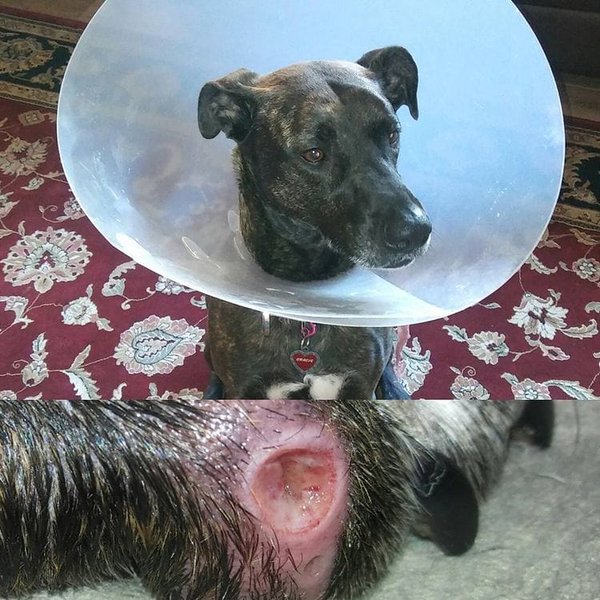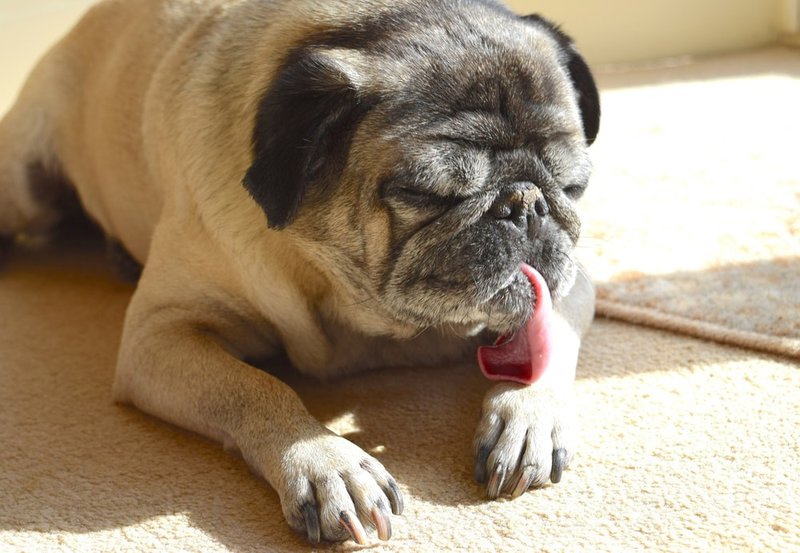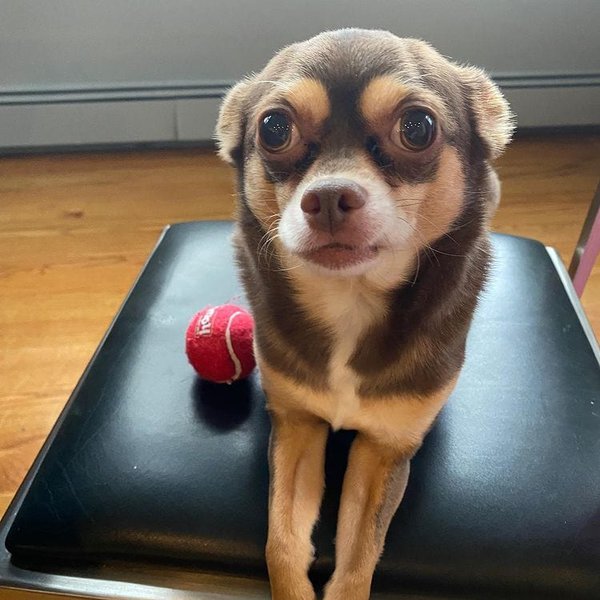Do you notice your dog spinning round and round like there is no tomorrow? Or, snapping its teeth in the air like it is battling a thousand flies? Then your dog may be suffering from obsessive-compulsive behavior (OCD).
Dogs can suffer from a compulsive disorder just like humans do. Canine OCD or Canine Compulsive Disorder (CCD), affects around 2% to 3% of dogs and is characterized by repetitive and excessive unvaried actions, which are difficult for a dog to control and manage, thereby affecting the quality of their lives.
The disorder can be attributed to stress, anxiety, the environment, or genetics. Although it is not yet fully understood by dog behaviorists since we cannot really know what dogs think, it bears a similar resemblance to human OCD where repetitive behaviors take over their lives.
In this article, we will look into detail about the root causes of OCD and the behaviors commonly seen in dogs suffering from this disorder, as well as the various ways we could minimize and treat it.
How Do Dogs Get OCD?
As mentioned, dogs can have OCD, and the reasons how they get it can be due to environmental, medical, or genetic factors.
In most cases, OCD tends to begin between the ages of 12 and 24 months. A lot of times, a trigger would start it and the initial behavior would begin as a coping mechanism.
As an example, when a dog gets into a stressful situation, i.e., hearing the sounds of a thunderstorm or has an underlying medical condition, it may start circling around its tail, biting its flank, or other acts of normal behavior in order to relieve stress.
It may learn over time that repeating such behaviors somehow reduces its anxiety and would continue the behavior repeatedly.
A dog’s body probably releases some neurotransmitters or endorphins every time they perform repetitive actions, and they get addicted to it. The initial trigger would no longer be needed to start the behavior and the habit reinforces them to feel better.
Once the compulsive disorder gets stronger with time, it may start to affect its regular eating and sleeping habits and eventually injure itself in the process.
Let’s now tackle each of the factors as to how dogs get OCD.
Environmental Reasons
Animal behaviorists believe that a lot of compulsive behaviors start because of a lack of physical and mental stimulation, meaning, these dogs are pain-free and in good shape.
For example, intelligent and active working breeds are stressed if they are not given a job to do. As a result, they may start to display displacement behaviors that can become compulsive if they are not stimulated enough.
Examples of displacement behaviors are yawning even if dogs are not tired and biting/scratching of body parts even if there are no irritants.
Another reason for triggering compulsive behaviors starts when you reward your dog with close attention to a particular behavior it has done. Maybe you found it cute when your dear Fido started spinning around its tail and you gave it a positive reinforcement by clapping or cheering. This may force the dog to repeat a behavior just to get your attention.
Dogs living in kennels and being caged for long periods of time can also develop behaviors of pacing, spinning, and circling. Living situations where they cannot express normal behaviors would trigger OCD.
Genetics
Some breeds may be genetically predisposed to compulsive behaviors.
For instance, Bull Terriers tend to chase their tail and spin, Miniature Schnauzers like to fly-snap. Dobermans tend to suck their flanks and are prone to acral lick dermatitis, and Labrador Retrievers like to pick up objects and eat them.
Some breeds are also prone to separation anxiety which could then trigger some strange behaviors. Small and medium-sized dogs usually have this problem.
Before the role of genetics is considered, disease or any medical condition is first checked to rule out any underlying causes.
Medical Reasons
An underlying medical condition or chronic pain from a past injury could trigger compulsive behaviors in some dogs.
Skin allergies and other dermatological diseases can be a source for the constant licking of an irritated body part. Itchiness may initially trigger a dog to scratch and lick that can then develop into compulsive behavior.
A pinched nerve or anal gland problem could also trigger compulsive behaviors for constant spinning or tail-chasing. It could also be neurological like a brain tumor, hydrocephalus, and epilepsy.
Can You Know If Your Dog Has OCD?

Yes, when a standard dog behavior, like spinning on its tail or licking its paws, becomes exaggerated and repetitive, then your dog may be suffering from a compulsive disorder.
There are several common behaviors and physical manifestations that indicate OCD is afflicting your dog. What does OCD in dogs look like? Let’s take a look now…
Acral Lick Dermatitis (ALD)
Also known as lick granuloma, this skin disorder is the result of excessive licking of the lower portion of the dog’s legs. This progresses to cause a bald spot and open sores or lesions that would eventually thicken forming an oval plaque or granuloma.
Tail-Chasing Or Spinning
This tail-chasing behavior is characterized by the constant spinning of the dog in tight circles in either direction. This often starts when a dog owner reinforces the behavior with too much attention.
Only when it gets obsessive that an owner notices that it is causing harm to the well-being of the dog.
Flank Sucking
This behavior can be described as a dog sucking or holding a piece of its flank skin with its mouth. This is common among Dobermans and is likely a displaced nursing behavior. The possible dangers of this behavior are self-mutilation.
If the behavior does not lead to serious physical injury and does not interfere with the welfare of the dog, flank sucking may be considered a normal coping mechanism for anxiety.
Fly-Snapping Syndrome
Also called fly-biting, air-snapping, or jaw-snapping, the fly-snapping syndrome is categorized as an oral compulsive behavior where the dog seems to snap at imaginary flies or bite the air for a period.
It can be accompanied by jumping, licking, and swallowing. In some instances, this could be a symptom of a partial seizure due to abnormal electrical activity in a small portion of the brain.
Pica
Pica is characterized by the compulsive eating of non-food items like rocks, paper, wood, or plastic.
A dog can obsess about eating a specific item, but others can exhibit ingesting anything that they can get hold of. This condition can be life-threatening since it might cause intestinal or bowel obstruction.
Other compulsive behaviors include polydipsia or excessive drinking, constant or rhythmic barking, pacing, or circling, freezing, or staring, and obsessive chewing on objects.
Oftentimes, these behaviors worsen over time and are accompanied by changes in the dog’s energy levels, substantial weight loss, and evidence of self-mutilation.
How Do You Treat Dogs With OCD?
There are several things you can do to modify the compulsive behavior of your dog.
Giving your dog the right amount of physical and mental stimuli, reducing stressful activities, removing negative reinforcement, distracting the repetitive behaviors. And when the going still gets tough, the vet may prescribe anti-anxiety pills.
Physical And Mental Exercise
The value of physical exercise cannot be stressed enough in relieving your dog of any compulsive disorders. Physical exertion not only keeps them active but also expands their energy to the point that it has no time to obsess over their behavioral disorders.
Mental stimulation is likewise important in calming your dog. Introducing it to new places, playing fetch, or engaging with interactive toys are great ways to stimulate the mind and decrease their boredom and anxiety.
There is a slew of new puzzle toys available in the market that you can enjoy playing with your dog.
For dogs suffering from obsessive licking or nibbling, giving them chewing toys with peanut butter inside can help them work with their mouths in other ways.
Reduce Stress
Since stress can trigger compulsive behaviors, it is important to know the source of the stress and then try to eliminate or reduce your dog’s exposure to it.
Making a list of the identifiable triggers could be useful and would go a long way in helping your dog deal with the stress.
Remove Negative Reinforcement
A lot of dog owners would usually find it funny and amusing at first when they see their dog displaying irrational and repetitive behaviors. By giving it attention and reinforcements through laughter and cheerful encouragement, the behavior could trigger the dog to do it more often.
When it becomes too frequent to the point of annoyance, the dog owner might lose patience and lash out at the dog reinforcing negative attention when it orders it to stop.
Distract The Behavior
A dog busy engaging with compulsive behavior can be distracted by using a remote indirect device like a water pistol, a whistle, or a simple tug on its leash. Once it is distracted, you start encouraging your dog to sit calmly or lie quietly.
Providing a positive reinforcement, like its favorite treats, thereafter would encourage the dog to establish this behavior.
Use Of Anti-Anxiety Drugs
In conjunction with behavior modification, a veterinarian may prescribe some drugs that can normalize brain neurotransmitter levels.
Studies have shown that dogs with OCD have an altered serotonin level which is responsible for stabilizing moods and anxiety. Anti-anxiety or psychotropic medications similar to what humans use are usually prescribed by veterinarians like Xanax, Prozac, or trazodone.






